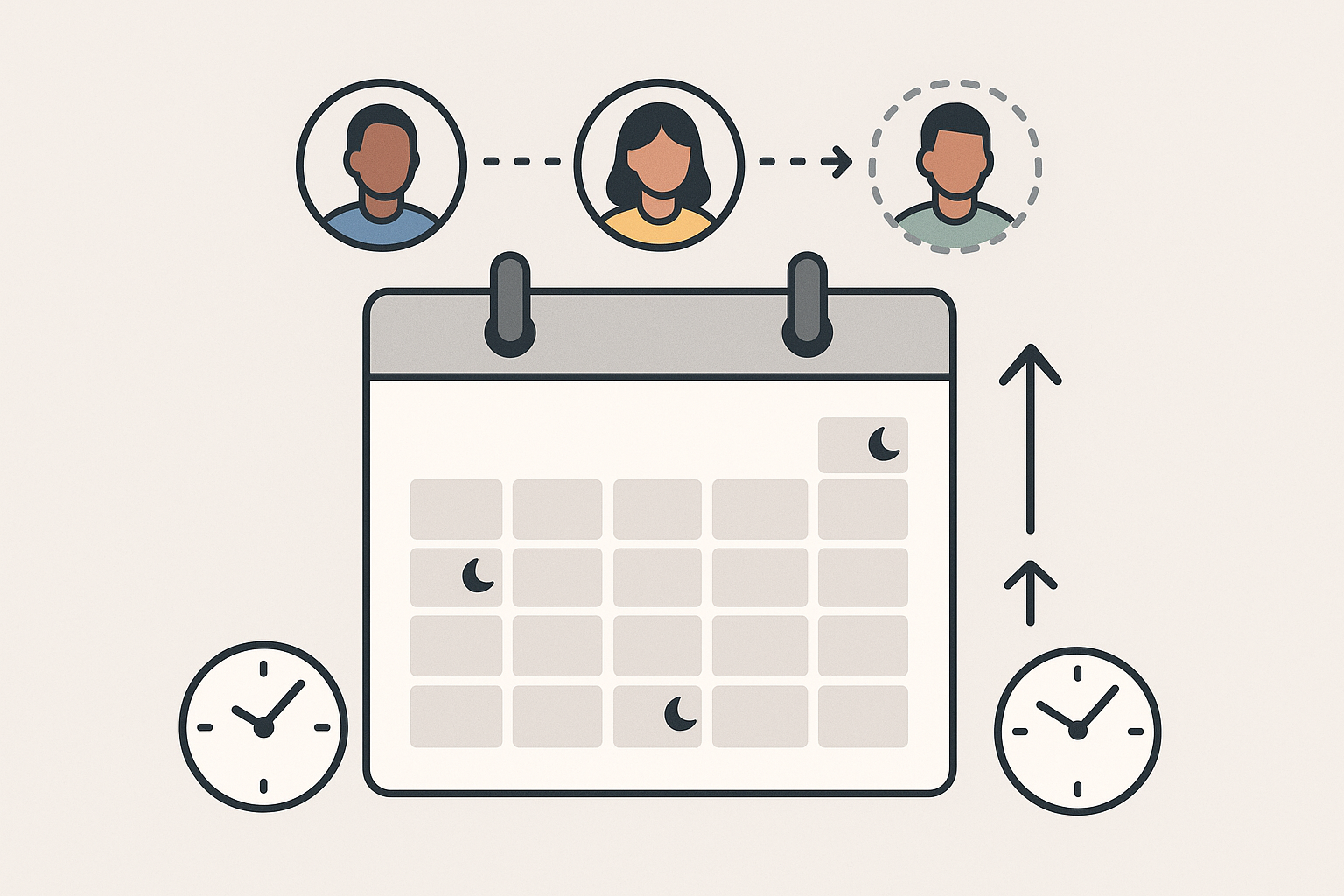A lightweight on-call schedule helps lean teams handle urgent customer emails after hours without burning people out. With a simple rotation, clear thresholds, and a few guardrails, you can cover nights and weekends while keeping morale high.
What an on-call schedule looks like in a small team
A good schedule is predictable, fair, and easy to swap. Keep ownership crystal clear: one primary handles incidents, while a backup is available for true emergencies. Define when to page immediately and when to queue work for morning so you avoid alert fatigue.
- Primary owns first response and status updates.
- Backup steps in only for high-severity or unresponsive primary.
- Coverage windows should match your customers’ time zones and SLAs.
- Swaps must be documented, not agreed in DMs.
Rotation types and coverage windows
- Weekly rotation: simplest for teams of 3–6; swap every Monday.
- Split-week rotation: Mon–Thu and Fri–Sun to balance weekends.
- Follow-the-sun: use local business hours across regions if you have them.
Build your on-call schedule in 30 minutes
You don’t need complex tooling to start. Create a single doc that lists the roster, coverage window, paging thresholds, and escalation path. Then add two runbooks for common issues.
- Choose the rotation length. Weekly is easiest; two weeks for very small teams.
- List the roster. Assign a primary and a backup for each week.
- Define thresholds. What pages at night vs. waits until morning?
- Set escalation steps. Notify → wait X minutes → escalate to backup → final owner.
- Write two runbooks. “Login issues” and “Payment failures” are common starters.
For routing rules and assignment tips, see our guide to ticket triage and simple rules that keep the inbox moving: small-team triage rules.
A simple, predictable rotation beats a complex roster that no one remembers.
Keep on-call fair and sustainable (and humane)
Fairness keeps the system working. Cap consecutive nights, rotate weekend burden, and give comp time after heavy nights. Track the actual after-hours load and adjust.
- Balance: limit back-to-back weekends for any single person.
- Comp time: allow a late start or time off after night alerts.
- Swap policy: require a named replacement and a note in the schedule doc.
- No heroics: if alerts spike, expand the roster or raise thresholds.
Practical metrics to watch
Measure just a few indicators and iterate weekly:
- Time to acknowledge (TTA): minutes from alert to first response.
- Time to resolve (TTR): clock time from alert to fix or workaround.
- Alerts per week per person: signals load and fairness.
For a deeper dive on which numbers matter, review our post on helpdesk metrics for small teams: helpdesk metrics to track.
Paging thresholds and severity (avoid alert fatigue)
Not every notification should wake someone up. Write short severity definitions, then tie them to paging behavior.
- Sev-1 (page immediately): security risk, payment outage, widespread login failure.
- Sev-2 (notify quietly): degraded performance, partial feature failure, manual workaround exists.
- Sev-3 (next business day): low impact, single account bugs, documentation requests.
Tip: if you see more than 3 night pages in a week, investigate root causes and raise thresholds until noise is under control.
Clear messages = faster fixes
Use saved replies and templates so status updates are consistent:
- Acknowledge receipt and set the next update time.
- Share what you checked and what you’ll try next.
- Ask for needed info in one message.
When you need ready-to-send phrasing, grab examples from our saved replies playbook: 15 templates for small teams.
Example weekly rotation you can copy
Start here, then refine:
Coverage window: 6pm–8am local time weekdays; 24h weekends and holidays.
Primary: Person A (Week 1), Person B (Week 2), Person C (Week 3) … rotate alphabetically.
Backup: Person B (Week 1), Person C (Week 2), Person A (Week 3) … follow the primary.
Escalation: Primary → Backup after 15 minutes with no ack → Engineering on-call for Sev-1 only.
Communication: Ticket notes + a single “#support-oncall” channel; no private DMs for active issues.
Comp time: If paged after midnight for Sev-1, start next day at 11am.
Handoff checklist at shift change
- Ticket ID and current status
- Next action and owner
- Customer update time promised
- Risks, blockers, and links to logs or screenshots
Iterate weekly with a short retro
Keep this light but consistent. Review alert volume, late acks, and any pages that should have waited. Adjust runbooks, thresholds, and the schedule. As your team grows, consider splitting rotations by domain (billing vs. auth) so expertise matches alerts.
Tools: start simple, upgrade later
Email-based helpdesks can run reliable on-call with minimal setup. As volume grows, adopt lightweight escalation and scheduling so the roster updates itself and everyone gets notified on time. If you’re not ready for enterprise tools, an affordable helpdesk plus clear policies still delivers great results.
Pricing note: Make on-call part of your support budget. If you need to forecast cost and pick the right plan, check our transparent pricing for small teams.
Conclusion
A well-designed on-call schedule gives customers fast help without exhausting the team. Start with a simple weekly rotation, add clear thresholds and runbooks, then iterate using a few metrics. The result is calmer nights, happier agents, and fewer missed incidents.
Start your free 14-day trial and set up simple on-call rotations and escalation without the bloat.
